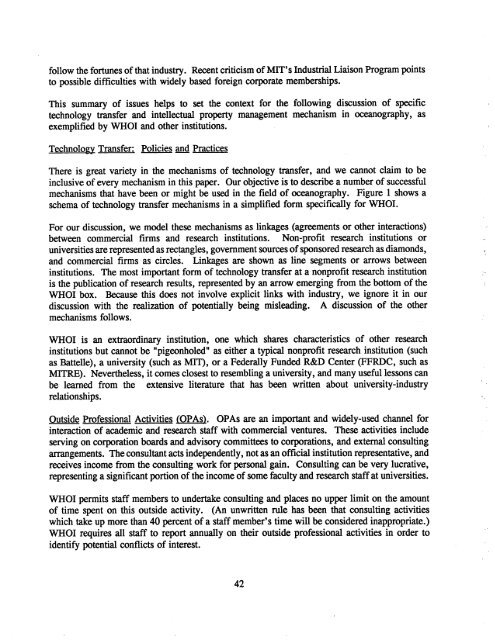WHOI-90-52
WHOI-90-52
WHOI-90-52
Create successful ePaper yourself
Turn your PDF publications into a flip-book with our unique Google optimized e-Paper software.
follow the fortunes of that industry. Recnt criticism of MIT's Industrial Liaison Program points<br />
to possible difficulties with widely base foreign corprate memberships.<br />
This summar of issues helps to set the context for the following discussion of speific<br />
tehnology trsfer and intellectual property management mechanism in ocography, as<br />
exemplified by <strong>WHOI</strong> and other institutions.<br />
Technology Transfer: Policies and Practices<br />
There is great varety in the mechanisms of technology trsfer, and we cannot claim to be<br />
inclusive of every mechanism in this paper. Our objective is to describe a number of successful<br />
mechanisms that have been or might be use in the field of ocography. Figure 1 shows a<br />
schema of tehnology trsfer mechanisms in a simplified form speificaly for WHO!.<br />
For our discussion, we model these mechanisms as linkages (agreements or other interactions)<br />
between commercial firms and resech institutions. Non-profit resech institutions or<br />
universities are represented as rectagles, government sources of sponsored resech as diamonds,<br />
and commercial firms as circles. Linkages are shown as line segments or arows between<br />
institutions. The most importt form of technology trsfer at a nonprofit resech institution<br />
is the publication of reseach results, represente by an arow emerging from the bottom of the<br />
<strong>WHOI</strong> box. Beuse this does not involve explicit links with industr, we ignore it in our<br />
discussion with the reaization of potentially being misleading. A discussion of the other<br />
mechanisms follows.<br />
<strong>WHOI</strong> is an extraordinar institution, one which shares characteristics of other resech<br />
institutions but canot be "pigeonholed" as either a typica nonprofit resech institution (such<br />
as Battelle), a university (such as MIT, or a Federally Funded R&D Center (FFRDC, such as<br />
MITR). Neverteless, it comes closest to resembling a university, and many useful<br />
lessons can<br />
be leaed from the extensive literature that has been written about university-industry<br />
relationships.<br />
Outside Professional Activities (OPAs), OPAs are an importt and widely-used channel for<br />
interaction of academic and resech staff with commercial ventures. These activities include<br />
serving on corpration boards and advisory committes to corprations, and external consulting<br />
argements. The consultat acts independently, not as an official institution representative, and<br />
recives income from the consulting work for personal gain. Consulting ca be very lucrative,<br />
representing a significat porton of the income of some faculty and resech staff at universities.<br />
<strong>WHOI</strong> permits staf members to underte consulting and places no upper limit on the amount<br />
of time spent on this outside activity. (An unwritten rulehas been that consulting activities<br />
which tae up more than 40 percent of a staff member's time wil be considered inappropriate.)<br />
<strong>WHOI</strong> requires all staff to report annually on their outside professional activities in order to<br />
identify potential conflcts of interest.<br />
42
















